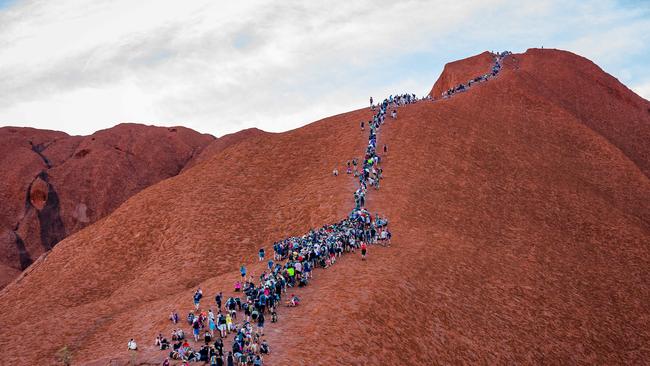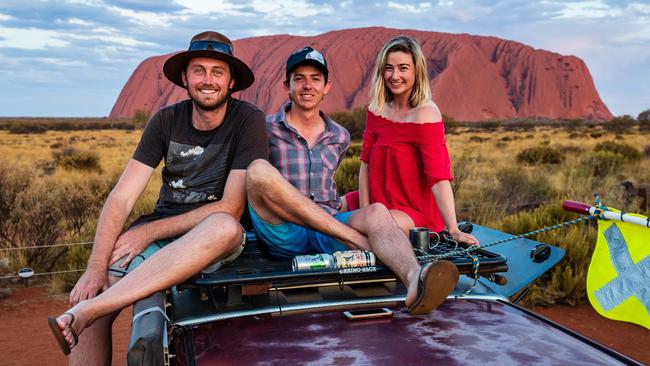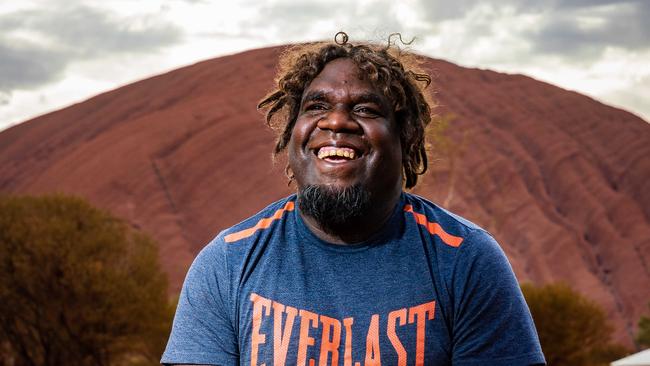Pilgrims flock for last chance to climb the natural wonder Uluru
Before the world-famous climb closes, many have travelled there in the hope of making a final dash.

They have been gathering in darkness in unprecedented numbers, reaching more than 1000 people at least twice this week as they strive for entry to the exclusive club of those who have scaled Australia’s rocky, red heart.
Exploiting the last school holidays before the world-famous Uluru climb closes on October 26, families have travelled from around the country and overseas in the hope of making a final dash for the summit.
You see their camper-trailers stopped on verges, their utes, SUVs and rental vehicles in overflowing carparks. As dawn gathers, they form a neat line snaking hundreds of metres around the rock’s base, waiting to hear if, on their day, the climb will open.
John Lauder, a retiree from Newcastle, left his wife and trekked halfway across the continent to start a queue before 4am. “I’m not leaving until I climb it,” Mr Lauder said.
He finally bounded through the gate on his fourth attempt, on Wednesday, when rangers opened the climb “early” just before 7am. The experience hardened Mr Lauder’s view that the “amazing” Uluru summit should remain available to everyone.
Craig Woods, a local Anangu man who has been watching visitors’ antics, described the scene as “two cultures colliding”: patriotic Aussies coming from far and wide to make a pilgrimage to a modern-day national icon. A few kilometres down the road, traditional owners whose identity was entwined with Uluru, the land and Dreaming stories branching into the desert, wish the climb had never become a tourist draw.

“We’ve got people across the continent who think their God-given rights are being taken away by a very small minority,” Mr Woods said. “They talk about their culture and their beliefs and that sort of stuff. There are two cultures colliding: one culture that’s maybe 300 years old and another that’s — I don’t know exactly how long Anangu have been here — much older.”
Michael and Rachel Wells and their three kids, from Werribee in Victoria, flew to Alice Springs and drove to Uluru-Kata Tjuta National Park for a three-day trip.
Ms Wells opted not to climb out of respect for Aboriginal wishes, but Mr Wells felt it was reasonable to go up while the climb remained open. He and six-year-old Harry made it halfway to the summit before pushing and shoving on the crowded route caused them to return. Ella, 13, continued alone.
“It just felt great, that sense of achievement, that I’ve made it to the top, and that I didn’t do it with Dad either,” Ella Wells said.
“I got up there; I didn’t struggle as much as I thought I would … and the view was just amazing.”
Uluru visitors justified their decisions to climb — or not — in different ways. Some said the rock was a natural gift that belonged to no one, others that it was in the whole nation’s custody.
Some thought climbing should have been banned long ago.
“I don’t know much about Aboriginal culture, but it (closing the climb) is obviously something that’s very important to them,” Ella Wells said. “It’s a little bit disappointing (that any children I might have won’t be able to go up), but I can share my experiences with them … and I can still take them there (to Uluru). If I have kids, they can still see it.”

Sinking stubbies atop their utes while watching Uluru’s famous sunset view, Grant Davies, Paul Carmody and Travis Hamm, all from Darwin, were not so sure.
“It’s a national shame,” Mr Carmody said. “There’s no spiritual reasons (to close the climb) … this is something that belongs to the whole country.”
Uluru has lately become synonymous with the rift baked into modern Australia as the place the Uluru Statement from the Heart was agreed and signed.
When the UKT board of management announced in 2017 that climbing would be banned from this October, then chair Sammy Wilson likened it to a fairground ride above a sacred monument and added that traditional owners had long “felt a sense of intimidation” to keep the climb open against their better judgment.
Very little else has been said since to help explain Aboriginal views. Campaigners against the closure have appealed to the Australian Human Rights Commission and the UN, saying the climb itself is World Heritage-listed. Aboriginal people took explorers to the top of Uluru as early as the 1940s, and historical records suggest previous custodians thought climbing the rock was acceptable.

Uluru visitors found these apparent contradictions tough to reconcile. Almost none had met an Anangu person.
Mr Woods explained the senior men who helped explorers climb Uluru many years ago did not know that in a few decades they might be followed by thousands of tourists. “If they had known, then they would’ve said no,” Mr Woods said.
Wayne Curtis, another local leader, agreed that if Anangu had changed their minds, then it was because allowing climbing in the first place had been a mistake.
At least 36 climbers have died in connection with the rock, mostly from heart conditions. Several Anangu cited safety as a major factor — alongside cultural obligations — behind the decision to ban climbing, likely forever.
“Anangu feel a huge sense of grief to hear that someone has passed away in their country, on the land,” Mr Woods said. “It doesn’t need to be on the climb; it can be anywhere in the park.”
Visitors to Uluru usually stay in the luxury Ayers Rock Resort — owned by the Indigenous Land and Sea Corporation — at Yulara, which has green grass, a supermarket and thriving businesses. Nearby community Mutitjulu is dusty, rundown and lacking economic engagement.
Just 18 of 906 Ayers Rock Resort employees and 10 of 40 Parks Australia employees identify as Anangu, and only a fraction of those come from Mutitjulu, which is home to almost 400 people.

